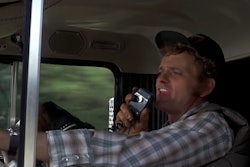Ken England, leased to Landstar System, admits that “you can ‘insurance yourself’ to death.” You might think the 54-year-old, who owns policies on his credit card balance, truck loan, home mortgage and business income, is a prime example. England would disagree.
“Some people think to themselves, ‘I’ve got a half-million life insurance policy,’ or ‘I’ve got $200,000, and that’s plenty.’ But if I was killed and my wife collects that $200,000, she still owes $150,000 on the house and this and that, a little on the truck that’s not paid for. There goes that life insurance policy.”
Nevertheless, whatever the odds of filing a warranty claim or collecting on a truck loan insurance policy, it’s ultimately “a crapshoot,” says John Powell of Blue Ridge Peterbilt in Fairfield, Va. “If you don’t need it, you wasted money,” he says. “If you do need it, it’s a great bargain.”
Here are three areas where it’s worth taking a close look at the costs and benefits of insuring against a worst-case scenario.
A new truck typically comes with a one-year bumper-to-bumper warranty as well as a longer (typically two-year) warranty on the engine and drivetrain, often including the transmission, with the option of paying up-front for extension. When that extension’s bumper-to-bumper, it can run $6,000 to $7,000, says John Powell, who sold owner-operator Chad Blackwell his 2007 Peterbilt 379 Legacy Edition.

“I always buy an extended warranty on the engine,” Blackwell says, “for around two or three grand.” That’s cheap insurance, considering the complexity of modern engines, Powell says.
“A simple injector can cost you a grand to $1,500,” owner-operator England says. Unlike Blackwell, who tends to run newer trucks, England hauls in a 1997 Kenworth T2000, which was tricked out a couple years ago for CMT’s “Trick My Truck.” He bought it in 2002 from the fleet he was leased to. Straight away he rebuilt its Caterpillar C12 and purchased a $560 two-year/200,000-mile warranty from the manufacturer. When an injector gave out, reimbursement for the towing bill alone “more than paid for the warranty itself,” England says.
As England’s case illustrates, if you’ve put money into a used truck via a rebuild or other repairs, most engine makers will offer warranty protection. Weighing the ultimate value of that warranty will involve not only its cost but the large operational choice the rebuild represents: keeping a used truck in good working order as opposed to short trading on new trucks and always running under factory extended warranty protection.
Overdrive 2007 Trucker of the Year Henry Albert, based near Charlotte, N.C., historically has opted for the five-year/500,000-mile extended protection bumper-to-bumper from Freightliner on a new truck. That’s a choice few make. Among warranty buyers surveyed for the Overdrive Owner-Operator Market Behavior Report, only 16 percent did so.
“Beyond that,” Albert says, “my experience has been that if you have your truck maintained, you don’t run into a whole lot. And I don’t keep my equipment long enough so that you’re having a lot of the big problems” that make a warranty worthwhile.
Keeping up with recommended maintenance reserves, according to the age of your truck and engine, Albert suggests, can provide the same sort of security against the risk of catastrophic failure that a warranty can. The Overdrive/ATBS Partners in Business manual recommends maintenance savings of 3 cents per mile for a new truck and up to 12 cents a mile for a truck more than 4 years old. But if you’re making large payments on a truck or rebuild loan and are unable to save adequately, Albert says, an extended warranty can be practical as a hedge against a breakdown.
Statesville, N.C.-based independent cattle hauler Ronald Millsaps runs a 2002 Pete 379 flattop he bought used and still under warranty. Before the warranty ran out, he extended the engine warranty three years/300,000 miles through his Caterpillar dealer at a cost of $3,100. He also extended the transmission 250,000 miles through his Peterbilt dealer and Eaton for $1,000.
The extension option, which can be thought of as a renewal of the existing factory extended warranty, is much more expensive than a warranty on a rebuild due to the increased risk of failure.
In Millsaps’ case, though, his foresight paid off when he went down at 781,000 miles with a blown head gasket, just before the warranty extension expired. The blow-out and other problems would have cost him upwards of $5,000 had he not had the warranty. If he fixed a turbo and his injectors, the dealer said, at a cost of about $6,000, he could extend his current warranty another three years/300,000 miles for $3,500. He went for it, in effect paying $9,500 for that three-year warranty – an expensive warranty, indeed. With a different operational choice ruling out extended warranties and focused on proactive maintenance saving, he might have gotten a little more life out of the turbo and injectors.
Owner-operators running nationwide without a large fleet’s national service network at their disposal can benefit from a breakdown-assistance program, via prepaid memberships or charges on a case-by-case basis. One of the newest breakdown services is used-truck warranty provider National Truck Protection’s Premium and Premium Plus programs, which provide varying levels of repair service, utilizing a network of 3,000-plus independent garages that honor their warranties.
“They bend over backward to make things right for any customer in any situation,” Bill Eelman says of NTP. Part-owner of Alexander Hay Greenhouses and sometime operator of a Peterbilt in the company’s private fleet, Eelman was the first member of the Premium Plus breakdown service, which comes at an annual cost of $99 for members of the Owner-Operator Independent Drivers Association, $199 for non-members. The lower-cost Premium program doesn’t include review of the repair bill by consultants in order to negotiate reduced cost and downtime.
Albert’s Freightliner is registered with Bridgestone/Firestone’s National Preferred program, which relies on its network of Bridgestone dealers and a “large database of mechanical stores that aren’t tire dealers,” says John Schmuke, the program’s operations manager. The program has no membership fee. It charges $27 for managing any tire-breakdown case, $54 for a non-tire breakdown. The main idea, Schmuke says, “is to not leave anybody on the side of the road and have somebody trying to rip them off.”
For an owner-operator like Albert, the peace of mind and the pay-as-you-go format make it a steal, even though he’s never had to use it. His attention to his Freightliner’s maintenance needs keeps him from having to pay the case fees levied during on-road breakdowns. When he needs work done, he schedules it locally with a shop he’s built a trusting relationship with.
“I do believe in having that much, though,” he says of the Bridgestone free registration, “so that you’re not out there in the dark.”
Truck and engine makers, other tire manufacturers and independent services offer similar programs, some with associated membership fees, some without. Be aware of extra surcharge fees that might be assessed if you’re not registered with any service prior to a breakdown. NTP’s program, for instance, requires a $40 or $50 surcharge for new members signing on at the time of a breakdown.
Owner-operator England takes a different approach to breakdowns. When an on-road repair requiring a tow isn’t covered by his engine warranty, he’s got a fall-back plan – towing and breakdown protection packaged with his truck insurance. The provider is Gallagher Transportation Services. He’d had physical-damage insurance on his T2000 previously through a truck stop chain, at $229 a month. Once he learned Gallagher’s physical damage policy would cost only $70 more and cover towing and on-road service within limits, he jumped on it.
Two years ago, cattle-hauling owner-operator Millsaps was loading in South Carolina when he got kicked by his cargo. His leg was broken, though he didn’t know it immediately. “I went on to Nebraska. A boy there offered to unload my truck for me, and by that time I was really hurting. I gave him $100 and told him to go buy me some crutches.” He eventually had another driver run his truck back, with him in the sleeper, wincing at every bump.
The broken leg put him out of business for three months. A bull accident once before had put him out of work, so Millsaps determined to protect himself.
“The best deal that my wife found was through OOIDA,” says Millsaps, now 55. That policy is a $65-a-month short-term disability plan guaranteed for new members, providing a $400 weekly benefit for a maximum of 52 weeks, “should illness or injury prevent you from working,” according to the plan’s description on ooida.com.
Occupational accident plans for owner-operators are often more limited than workers compensation plans that carriers provide for company drivers. A shorter time period for benefits, for instance, is often specified. Owner-operator England pays just more than $100 monthly for his occupational accident plan, bought through Flying J Insurance Services independent of his carrier, Landstar. But he also carries a long-term disability policy through the same company, for nearly the same price.
But if you have a back-up batter, says owner-operator Albert, “do you need to pay to replace your batter if he goes down? I can see having a disability policy if both [myself and my wife] were working outside the house and we needed every penny of that money.” Before she began home-schooling the Alberts’ child, Henry’s wife, Karen, worked in hotel sales and real estate. Now Albert thinks that if he goes down, she comes out. A younger driver making good profit and with plenty savings to potentially draw on might bet on his own ability to avoid accidents and stay healthy and not take out a disability policy, instead saving the extra in a rainy-day fund.
England ran this way without incident up to four years ago, when he was 49. “I’m 54 now,” says England. “I’m not young anymore.” With a son in college, he’s mindful of the potential burden his inability to work would put on his family. With all the bases covered, he says, “if something happens to me, everything will be paid off and [my wife] will have the life insurance to live off of.”














